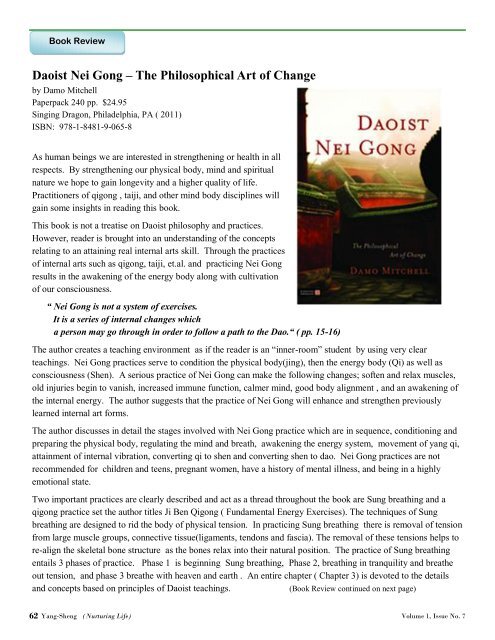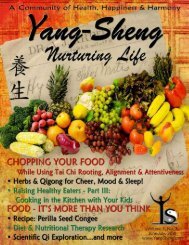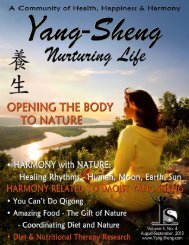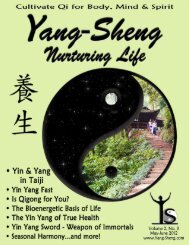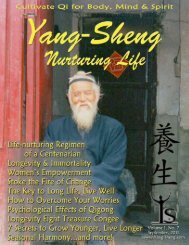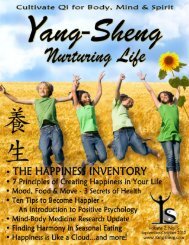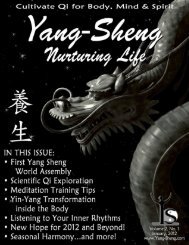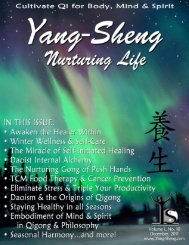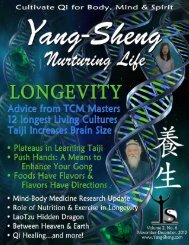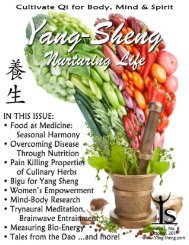Click to download the entire September issue as a PDF - Yang-Sheng
Click to download the entire September issue as a PDF - Yang-Sheng
Click to download the entire September issue as a PDF - Yang-Sheng
Create successful ePaper yourself
Turn your PDF publications into a flip-book with our unique Google optimized e-Paper software.
Book Review<br />
Daoist Nei Gong – The Philosophical Art of Change<br />
by Damo Mitchell<br />
Paperpack 240 pp. $24.95<br />
Singing Dragon, Philadelphia, PA ( 2011)<br />
ISBN: 978-1-8481-9-065-8<br />
As human beings we are interested in streng<strong>the</strong>ning or health in all<br />
respects. By streng<strong>the</strong>ning our physical body, mind and spiritual<br />
nature we hope <strong>to</strong> gain longevity and a higher quality of life.<br />
Practitioners of qigong , taiji, and o<strong>the</strong>r mind body disciplines will<br />
gain some insights in reading this book.<br />
This book is not a treatise on Daoist philosophy and practices.<br />
However, reader is brought in<strong>to</strong> an understanding of <strong>the</strong> concepts<br />
relating <strong>to</strong> an attaining real internal arts skill. Through <strong>the</strong> practices<br />
of internal arts such <strong>as</strong> qigong, taiji, et.al. and practicing Nei Gong<br />
results in <strong>the</strong> awakening of <strong>the</strong> energy body along with cultivation<br />
of our consciousness.<br />
“ Nei Gong is not a system of exercises.<br />
It is a series of internal changes which<br />
a person may go through in order <strong>to</strong> follow a path <strong>to</strong> <strong>the</strong> Dao.“ ( pp. 15-16)<br />
The author creates a teaching environment <strong>as</strong> if <strong>the</strong> reader is an ―inner-room‖ student by using very clear<br />
teachings. Nei Gong practices serve <strong>to</strong> condition <strong>the</strong> physical body(jing), <strong>the</strong>n <strong>the</strong> energy body (Qi) <strong>as</strong> well <strong>as</strong><br />
consciousness (Shen). A serious practice of Nei Gong can make <strong>the</strong> following changes; soften and relax muscles,<br />
old injuries begin <strong>to</strong> vanish, incre<strong>as</strong>ed immune function, calmer mind, good body alignment , and an awakening of<br />
<strong>the</strong> internal energy. The author suggests that <strong>the</strong> practice of Nei Gong will enhance and streng<strong>the</strong>n previously<br />
learned internal art forms.<br />
The author discusses in detail <strong>the</strong> stages involved with Nei Gong practice which are in sequence, conditioning and<br />
preparing <strong>the</strong> physical body, regulating <strong>the</strong> mind and breath, awakening <strong>the</strong> energy system, movement of yang qi,<br />
attainment of internal vibration, converting qi <strong>to</strong> shen and converting shen <strong>to</strong> dao. Nei Gong practices are not<br />
recommended for children and teens, pregnant women, have a his<strong>to</strong>ry of mental illness, and being in a highly<br />
emotional state.<br />
Two important practices are clearly described and act <strong>as</strong> a thread throughout <strong>the</strong> book are Sung breathing and a<br />
qigong practice set <strong>the</strong> author titles Ji Ben Qigong ( Fundamental Energy Exercises). The techniques of Sung<br />
breathing are designed <strong>to</strong> rid <strong>the</strong> body of physical tension. In practicing Sung breathing <strong>the</strong>re is removal of tension<br />
from large muscle groups, connective t<strong>issue</strong>(ligaments, tendons and f<strong>as</strong>cia). The removal of <strong>the</strong>se tensions helps <strong>to</strong><br />
re-align <strong>the</strong> skeletal bone structure <strong>as</strong> <strong>the</strong> bones relax in<strong>to</strong> <strong>the</strong>ir natural position. The practice of Sung breathing<br />
entails 3 ph<strong>as</strong>es of practice. Ph<strong>as</strong>e 1 is beginning Sung breathing, Ph<strong>as</strong>e 2, breathing in tranquility and brea<strong>the</strong><br />
out tension, and ph<strong>as</strong>e 3 brea<strong>the</strong> with heaven and earth . An <strong>entire</strong> chapter ( Chapter 3) is devoted <strong>to</strong> <strong>the</strong> details<br />
and concepts b<strong>as</strong>ed on principles of Daoist teachings.<br />
(Book Review continued on next page)<br />
62 <strong>Yang</strong>-<strong>Sheng</strong> (Nurturing Life) Volume 1, Issue No. 7


